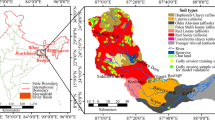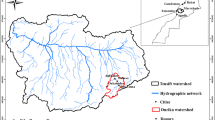Abstract
The research on effective methods for assessing areas susceptible to gully erosion has environmental, agricultural and economic benefits to society. This study aimed to identify the areas with high susceptibility to gully erosion using two statistical methods and compare the performances. Remote sensing and field data along with two statistical methods, information value (InfVal) and logistic regression, were applied in the analysis. Gullies, boundary demarcation and regulating erosion processes were surveyed and mapped in a GIS environment. Gully sites were split into training and validation set for modelling and validating susceptibility results. The geo-environmental variables selected, according to study area, were land use/land cover, slope steepness, slope aspect, elevation range, length-slope factor, topographical wetness and position index, stream power index, geology, soil type, rainfall erosivity index and altitude. Weights for each class of each variable were computed through InfVal method and probabilities of occurrence of 1,000,000 random locations were extracted to run the logistic regression operation. A weighted linear combination approach and an inverse distance weighted approach were applied for the InfVal and logistic regression methods, respectively, to generate the gully proneness maps. Both results were classified into five susceptibility classes and they depict 18.44% (Infval) and 12.67% (logistic regression) area of the catchment as high to very highly susceptible to gully erosion. Correlation analysis between the results revealed a coefficient value of 0.8379. For InfVal model, the success and prediction rate is 78% and 75% whereas for the logistic regression model, it is 73% and 72.9% accordingly.













Similar content being viewed by others
References
Achour Y, Boumezbeur A, Hadji R, Chouabbi A, Cavaleiro V, Bendaoud EA (2017) Landslide susceptibility mapping using analytic hierarchy process and information value methods along a highway road section in Constantine, Algeria. Arab J Geosci. https://doi.org/10.1007/s12517-017-2980-6
Aleotti P, Chowdhury R (1999) Landslide hazard assessment: summary review and new perspectives. Bull Eng Geol Env 58:21–44
Atkinson PM, Massari R (1998) Generalized linear modelling of susceptibility to landsliding in the central Appennines, Italy. Comput Geosci 24(4):373–385
Ayalew L, Yamagishi H (2005) The application of GIS-based logistic regression for landslide susceptibility mapping in the Kakuda-Yahiko Mountains Central Japan. Geomorphology 65:15–31
BouKheir R, Wilson J, Deng Y (2007) Use of terrain variables for mapping gully erosion susceptibility in Lebanon. Earth Surf Proc Land 32:1770–1782
Buttafuoco G, Conforti M, Aucelli PPC, Robustelli G, Scarciglia F (2012) Assessing spatial uncertainty in mapping soil erodibility factor using geostatistical stochastic simulation. Environ Earth Science 66:1111–1125
Choudhury MK, Nayak T (2003) Estimation of soil erosion in Sagar lake catchment of central India. In: Proceedings of the international conference on water and environment, Dec 15–18, 2003, Bhopal, India, pp 387–392
Chung CF, Fabbri AG (2003) Validation of spatial prediction models for landslide hazard mapping. Nat Hazards 30:451–472
Conforti M, Aucelli PP, Robustelli G, Scarciglia F (2010) Geomorphology and GIS analysis for mapping gully erosion susceptibility in the Turbolo stream catchment (Northern Calabria, Italy). Nat Hazards 56(3):881–898. https://doi.org/10.1007/s11069-010-9598-2
Conoscenti C, Di Maggio C, Rotigliano E (2008) Soil erosion susceptibility assessment and validation using a geostatistical multivariate approach: a test in Southern Sicily. Nat Hazards 46:287–305. https://doi.org/10.1007/s11069-007-9188-0
Conoscenti C, Angileri S, Cappadonia C, Rotigliano E, Agnesi V, Märker M (2014) Gully erosion susceptibility assessment by means of GIS-based logistic regression: a case of Sicily (Italy). Geomorphology 204:399–411. https://doi.org/10.1016/j.geomorph.2013.08.021
Dahal RK, Hasegawa S, Bhandary NP, Poudel PP, Nonomura A, Yatabe R (2012) A replication of landslide hazard mapping at catchment scale. Geo Nat Hazards Risk 3:161–192
Dai FC, Lee CF, Li J, Xu ZW (2001) Assessment of landslide susceptibility on the natural terrain of Lantau Island, Hong Kong. Environ Geol 40:381–391
Das B, Paul A, Bordoloi R, Tripathi OP, Pandey PK (2018) Soil erosion risk assessment of hilly terrain through integrated approach of RUSLE and geospatial technology: a case study of Tirap District, Arunachal Pradesh. Model Earth Syst Environ 4(1):373–381
Deng Q, Qin F, Zhang B, Wang H, Luo M, Shu C, Liu G (2015) Characterizing the morphology of gully cross-sections based on PCA: a case of Yuanmou Dry-Hot Valley. Geomorphology 228:703–713. https://doi.org/10.1016/j.geomorph.2014.10.032
Dutta D, Das S, Kundu A, Taj A (2015) Soil erosion risk assessment in Sanjal watershed, Jharkhand (India) using geo-informatics, RUSLE model and TRMM data. Model Earth Syst Environ 1(4):37
Erskine W (2005) Gully erosion. In: Lehr J, Keeley J (eds) Water encyclopaedia: surface and agricultural water. Wiley-Interscience, Hoboken, pp 183–188
Gayen A, Saha S (2017) Deforestation probable area predicted by logistic regression in Pathro river basin: a tributary of Ajay River. Spat Inf Res. https://doi.org/10.1007/s41324-017-0151-1
Ghosh S, Guchhait SK (2016) Geomorphic threshold estimation for gully erosion in the lateritic soil of Birbhum, West Bengal, India. Soil Discuss. https://doi.org/10.5194/soil-2016-48
Hong H, Tsangaratos P, Ilia I, Chen W, Xu C (2017) Comparing the performance of a logistic regression and a random forest model in landslide susceptibility assessments. The Case of Wuyaun Area, China. Adv Cult Living Landslides. https://doi.org/10.1007/978-3-319-53498-5_118
Jenks GF (1989) Geographic logic in line generalization. Cartographica 26(1):27–42
Kakembo V, Xanga WW, Rowntree K (2009) Topographic thresholds in gully development on the hillslopes of communal areas in Ngqushwa Local Municipality, Eastern Cape, South Africa. Geomorphology 110:188–195
Lee S, Pradhan B (2006) Landslide hazard mapping at Selangor, Malaysia using frequency ratio and logistic regression models. Landslides 4(1):33–41. https://doi.org/10.1007/s10346-006-0047-y
Magliulo P (2012) Assessing the susceptibility to water-induced soil erosion using a geomorphological, bivariate statistics-based approach. Environ Earth Sci 67(6):1801–1820. https://doi.org/10.1007/s12665-012-1634-y
Moore ID, Burch GJ (1986) Physical basis of the length-slope factor in the universal soil loss equation. Soil Sci Soc Am J 50:1294–1298
Moore ID, Grayson RB, Ladson AR (1991) Digital terrain modelling: a review of hydrological, geomorphological, and biological applications. Hydrol Process 5:3–30
Nagarajan R, Roy A, Vinod Kumar R, Mukherjee A, Khire MV (2000) Landslide hazard susceptibility mapping based on terrain and climatic factors for tropical monsoon regions. Bull Eng Geol Env 58:275–287
Nearing MA, Foster GR, Lane LJ, Finkner SC (1989) A process-based soil erosion model for USDA water erosion prediction project technology. Trans ASAE 32:1587–1593
Onori F, De Bonis P, Grauso S (2006) Soil erosion prediction at the basin scale using the revised universal soil loss equation (RUSLE) in a catchment of Sicily (southern Italy). Environ Geol 50:1129 1140
Pal S, Talukdar S (2018) Application of frequency ratio and logistic regression models for assessing physical wetland vulnerability in Punarbhaba river basin of Indo-Bangladesh. Hum Ecol Risk Assess Int J. https://doi.org/10.1080/10807039.2017.1411781
Pandey A, Chowdary VM, Mal BC (2006) Identification of critical erosion prone areas in the small agricultural watershed using USLE, GIS and remote sensing. Water Resour Manage 21(4):729–746. https://doi.org/10.1007/s11269-006-9061-z
Poesen J, Nachtergale J, Vertstraeten G, Valentin C (2003) Gully erosion and environmental change: importance and research needs. Catena 50:91–133
Pulice I, Cappadonia C, Conoscenti CSFRG, De Rose R, Rotigliano E, Agnesi V (2012) Geomorphological, chemical and physical study of “calanchi” landforms in NW Sicily (Southern Italy). Geomorphology 153–154:219–231
Raja NB, Çiçek I, Türkoğlu N, Aydin O, Kawasaki A (2016) Correction to: landslide susceptibility mapping of the Sera River Basin using logistic regression model. Nat Hazards. https://doi.org/10.1007/s11069-017-3145-3
Rautela P, Lakhera RC (2000) Landslide risk analysis between Giri and Ton Rivers in Himalaya (India). Int J Appl Earth Obs Geoinf 2:153–160
Remondo J, Gonzalez A, Teran J, Cendrero A, Fabbri A, Chung C (2003) Validation of landslide susceptibility maps; examples and applications from a case study in Northern Spain. Nat Hazards 30:437–449
Roshan G, Negahban S (2015) Modeling of the effects of climate change on rainy and gully erosion potential of Kor-chamriz watershed in Fars province. Model Earth Syst Environ 1(3):1–26
Shit PK, Paira R, Bhunia G, Maiti R (2015) Modeling of potential gully erosion hazard using geo-spatial technology at Garbheta block, West Bengal in India. Model Earth Syst Environ 1(1–2):2
Smith GH (1935) The relative relief of Ohio. Geogr Rev 25:272–284
Suzen ML, Doyuran V (2004) Data driven bivariate landslide susceptibility assessment using geographical information systems: a method and application to Asarsuyu catchment Turkey. Eng Geol 71:303–321
Talaei R (2014) Landslide susceptibility zonation mapping using logistic regression and its validation in Hashtchin Region, northwest of Iran. J Geol Soc India 84(1):68–86. https://doi.org/10.1007/s12594-014-0111-5
Thornbury WD (1969) Principles of geomorphology, 2nd edn. Wiley, New York
Valentin C, Poesen J, Li Y (2005) Gully erosion: impacts, factors and control. Catena 63(2–3):132–153. https://doi.org/10.1016/j.catena.2005.06.001
Van Western CJ (1993) Application of Geographical Information System to landslide hazard zonation. ITC, International institute for aerospace and earth res. surv. ITC, Enschede
Yilmaz I (2009) Landslide susceptibility mapping using frequency ratio, logistic regression, artificial neural networks and their comparison: a case study from Kat landslides (Tokat—Turkey). Comput Geosci 35(6):1125–1138. https://doi.org/10.1016/j.cageo.2008.08.007
Yin KJ, Yan TZ (1988) Statistical prediction model for slope instability of metamorphosed rocks. In: Proceedings of the 5th international symposium on landslides, Lausanne, Switzerland, vol 2, pp 1269–1272
Zakerinejad R, Maerker M (2015) An integrated assessment of soil erosion dynamics with special emphasis on gully erosion in the Mazayjan basin, southwestern Iran. Nat Hazards 79(S1):25–50. https://doi.org/10.1007/s11069-015-1700-3
Acknowledgements
The authors would like to express cordial thanks to our respected teachers of Department of Geography, University of Gour Banga, who have always been mentally, economically and infrastructurally supported ourselves. Authors would also like to thanks the inhabitants of this basin because they have helped a lot during our field visit. At last, authors would like to acknowledge all of the agencies and individuals specially, Survey of India (SOI), Geological Survey of India (GSI) and USGS for obtaining the maps and data required for the study.
Author information
Authors and Affiliations
Corresponding author
Additional information
Publisher’s Note
Springer Nature remains neutral with regard to jurisdictional claims in published maps and institutional affiliations.
Electronic supplementary material
Below is the link to the electronic supplementary material.
Rights and permissions
About this article
Cite this article
Hembram, T.k., Paul, G.C. & Saha, S. Spatial prediction of susceptibility to gully erosion in Jainti River basin, Eastern India: a comparison of information value and logistic regression models. Model. Earth Syst. Environ. 5, 689–708 (2019). https://doi.org/10.1007/s40808-018-0560-8
Received:
Accepted:
Published:
Issue Date:
DOI: https://doi.org/10.1007/s40808-018-0560-8




